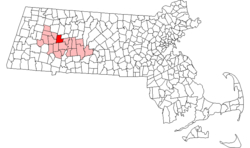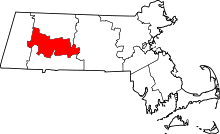Williamsburg, Massachusetts
| Williamsburg, Massachusetts | ||
|---|---|---|
| Town | ||
|
Williamsburg General Store | ||
| ||
 Location in Hampshire County in Massachusetts | ||
| Coordinates: 42°23′35″N 72°43′50″W / 42.39306°N 72.73056°WCoordinates: 42°23′35″N 72°43′50″W / 42.39306°N 72.73056°W | ||
| Country | United States | |
| State | Massachusetts | |
| County | Hampshire | |
| Settled | 1735 | |
| Incorporated | 1775 | |
| Government | ||
| • Type | Open town meeting | |
| Area | ||
| • Total | 25.7 sq mi (66.6 km2) | |
| • Land | 25.6 sq mi (66.4 km2) | |
| • Water | 0.1 sq mi (0.2 km2) | |
| Elevation | 530 ft (162 m) | |
| Population (2000) | ||
| • Total | 2,427 | |
| • Density | 94.7/sq mi (36.6/km2) | |
| Time zone | Eastern (UTC-5) | |
| • Summer (DST) | Eastern (UTC-4) | |
| ZIP code | 01039, 01096 | |
| Area code(s) | 413 | |
| FIPS code | 25-79915 | |
| GNIS feature ID | 0618211 | |
| Website | http://www.burgy.org/ | |
Williamsburg is a town in Hampshire County, Massachusetts, United States. The population was 2,482 at the 2010 census. It is part of the Springfield, Massachusetts Metropolitan Statistical Area.
History
Williamsburg was first settled in 1735 and was officially incorporated in 1775.
The Mill River Flood
On the morning of May 16, 1874, a flood along Williamsburg's Mill River claimed 139 lives and left nearly 800 victims homeless throughout Hampshire County. The deluge occurred when the Williamsburg Reservoir Dam unexpectedly burst, sending a twenty-foot wall of water surging into the valley below. Every town and village along the river's normally placid flow was soon devastated by the great rush of water. Much of the flood's force was abated in Northampton, Massachusetts, at the Mill River's confluence with the Connecticut River. Located over twelve miles from the breached dam in Williamsburg, Northampton was the last town to experience the flood's fury, with four additional victims swept away in the swell.[1]
Geography
According to the United States Census Bureau, the town has a total area of 25.7 square miles (67 km2), of which 25.6 square miles (66 km2) is land and 0.1 square miles (0.26 km2) (0.35%) is water. The town also includes the villages of Haydenville and Searsville.
Demographics
| Historical population | ||
|---|---|---|
| Year | Pop. | ±% |
| 1850 | 1,537 | — |
| 1860 | 2,095 | +36.3% |
| 1870 | 2,159 | +3.1% |
| 1880 | 2,234 | +3.5% |
| 1890 | 2,057 | −7.9% |
| 1900 | 1,926 | −6.4% |
| 1910 | 2,132 | +10.7% |
| 1920 | 1,866 | −12.5% |
| 1930 | 1,801 | −3.5% |
| 1940 | 1,684 | −6.5% |
| 1950 | 2,056 | +22.1% |
| 1960 | 2,186 | +6.3% |
| 1970 | 2,342 | +7.1% |
| 1980 | 2,237 | −4.5% |
| 1990 | 2,515 | +12.4% |
| 2000 | 2,427 | −3.5% |
| 2010 | 2,482 | +2.3% |
| * = population estimate. Source: United States Census records and Population Estimates Program data.[2][3][4][5][6][7][8][9][10][11] | ||
As of the census[12] of 2000, there were 2,427 people, 1,027 households, and 658 families residing in the town. The population density was 94.7 people per square mile (36.6/km²). There were 1,073 housing units at an average density of 41.9 per square mile (16.2/km²). The racial makeup of the town was 97.94% White, 0.25% African American, 0.08% Native American, 0.49% Asian, 0.16% from other races, and 1.07% from two or more races. Hispanic or Latino of any race were 0.66% of the population.
There were 1,027 households out of which 29.4% had children under the age of 18 living with them, 51.7% were married couples living together, 8.8% had a female householder with no husband present, and 35.9% were non-families. 25.1% of all households were made up of individuals and 9.1% had someone living alone who was 65 years of age or older. The average household size was 2.36 and the average family size was 2.88.
In the town the population was spread out with 21.3% under the age of 18, 5.0% from 18 to 24, 29.4% from 25 to 44, 31.4% from 45 to 64, and 12.9% who were 65 years of age or older. The median age was 42 years. For every 100 females there were 89.3 males. For every 100 females age 18 and over, there were 89.2 males.
The median income for a household in the town was $47,250, and the median income for a family was $55,833. Males had a median income of $36,977 versus $28,906 for females. The per capita income for the town was $25,813. About 1.2% of families and 5.5% of the population were below the poverty line, including 2.9% of those under age 18 and 10.7% of those age 65 or over.
Notable people
- Argalus Starks, Wisconsin state legislator.
- Edward Thorndike, prominent educational psychologist and eugenicist.
- Bob Toski, golfer and teaching professional. Winner of 11 professional golf tournaments.
- Patricia MacLachlan, author of best-selling books such as Sarah, Plain and Tall.
- Sarah Thomas Vice President for Libraries, Harvard University.
- Tracy Kidder, author and Pulitzer Prize winner
References
- ↑ Elizabeth M. Sharpe, In the Shadow of the Dam, Free Press, New York, 2004, pages 238-239
- ↑ "TOTAL POPULATION (P1), 2010 Census Summary File 1". American FactFinder, All County Subdivisions within Massachusetts. United States Census Bureau. 2010.
- ↑ "Massachusetts by Place and County Subdivision - GCT-T1. Population Estimates". United States Census Bureau. Retrieved July 12, 2011.
- ↑ "1990 Census of Population, General Population Characteristics: Massachusetts" (PDF). US Census Bureau. December 1990. Table 76: General Characteristics of Persons, Households, and Families: 1990. 1990 CP-1-23. Retrieved July 12, 2011.
- ↑ "1980 Census of the Population, Number of Inhabitants: Massachusetts" (PDF). US Census Bureau. December 1981. Table 4. Populations of County Subdivisions: 1960 to 1980. PC80-1-A23. Retrieved July 12, 2011.
- ↑ "1950 Census of Population" (PDF). Bureau of the Census. 1952. Section 6, Pages 21-10 and 21-11, Massachusetts Table 6. Population of Counties by Minor Civil Divisions: 1930 to 1950. Retrieved July 12, 2011.
- ↑ "1920 Census of Population" (PDF). Bureau of the Census. Number of Inhabitants, by Counties and Minor Civil Divisions. Pages 21-5 through 21-7. Massachusetts Table 2. Population of Counties by Minor Civil Divisions: 1920, 1910, and 1920. Retrieved July 12, 2011.
- ↑ "1890 Census of the Population" (PDF). Department of the Interior, Census Office. Pages 179 through 182. Massachusetts Table 5. Population of States and Territories by Minor Civil Divisions: 1880 and 1890. Retrieved July 12, 2011.
- ↑ "1870 Census of the Population" (PDF). Department of the Interior, Census Office. 1872. Pages 217 through 220. Table IX. Population of Minor Civil Divisions, &c. Massachusetts. Retrieved July 12, 2011.
- ↑ "1860 Census" (PDF). Department of the Interior, Census Office. 1864. Pages 220 through 226. State of Massachusetts Table No. 3. Populations of Cities, Towns, &c. Retrieved July 12, 2011.
- ↑ "1850 Census" (PDF). Department of the Interior, Census Office. 1854. Pages 338 through 393. Populations of Cities, Towns, &c. Retrieved July 12, 2011.
- ↑ "American FactFinder". United States Census Bureau. Retrieved 2008-01-31.
External links
| Wikimedia Commons has media related to Williamsburg, Massachusetts. |


